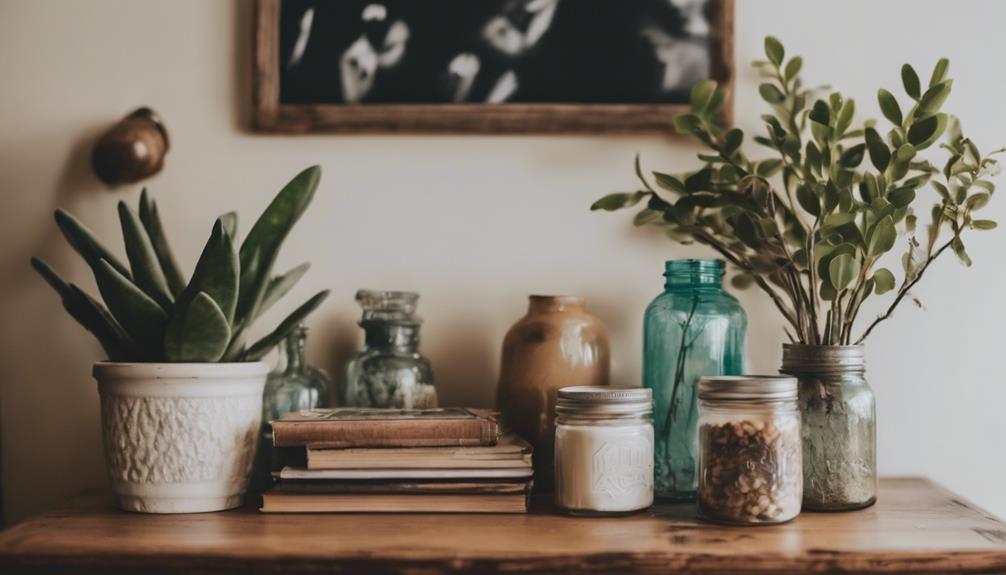Designing a home office inspired by Afrofuturism allows you to combine African cultural elements with modern design to create a lively workspace. Begin with bold, earthy colors such as warm oranges and deep reds to spark creativity. Integrate natural materials like wood and rattan for authenticity, and incorporate vibrant African textiles to add visual interest. Select key furniture pieces like a geometric coffee table and a mid-century desk chair to strike a balance between style and comfort. Enhance the ambiance with smart lighting options such as neon floor lamps and artistic sconces. Through carefully choosing decor and accents, your office can become a place of inspiration and productivity. Are you ready to revamp your space?
Key Elements

When designing your Afrofuturism-inspired home office, focus on the color scheme, materials, and textures that resonate with the culture.
Bold and earthy tones will invigorate your space, while natural materials like wood and rattan add depth and authenticity.
Incorporating these key elements will create a vibrant and inspiring workspace that reflects your appreciation for Black heritage.
Color Scheme
A thoughtfully chosen color scheme inspired by the African landscape can transform your home office into a vibrant space that boosts creativity and productivity. By selecting a color palette featuring warm oranges, rich browns, and deep reds, you can create a warm and inviting atmosphere. These bold tones reflect the continent's rich heritage while stimulating inspiration.
Cohesive color schemes applied to walls, furniture, and accessories foster a visually appealing environment that encourages focus and creativity. Incorporating vibrant colors inspired by African culture adds a lively touch, celebrating cultural identity in your workspace.
Layering colors through various elements like artwork, textiles, and furniture not only adds depth but also creates visual interest. For instance, pairing warm oranges with lush greens can evoke the beauty of the African landscape, making your home office both engaging and uplifting.
Materials
Incorporating natural materials like wood and rattan in your furniture choices brings warmth and adventure to your Afrofuturism-inspired home office. These elements not only create a welcoming atmosphere but also reflect the beauty of African landscapes.
Pair these materials with vibrant African textiles, such as Kente cloth or Mudcloth, for upholstery and decorative accents. This enhances the visual appeal while honoring the cultural richness that Afrofuturism embodies.
Don't overlook the importance of lighting fixtures; opt for those with natural textures, like woven shades or bamboo accents. They add authenticity to your space and help improve your mood as you work.
To introduce a futuristic touch, consider integrating art pieces made from acrylic and chrome. These elements align perfectly with your theme and serve functional purposes too.
Textures
Textures play an essential role in creating an inviting and dynamic atmosphere in your Afrofuturism-inspired home office. You can incorporate natural textures, like woven baskets and rattan furniture, to add warmth and authenticity to the space.
Consider using African textiles, such as Kente cloth or Mudcloth, for upholstery or wall hangings; these vibrant patterns introduce tactile richness and celebrate cultural heritage.
Mixing materials is key to achieving that perfect balance of traditional and futuristic aesthetics. Pairing metal accents with wooden furniture not only creates visual contrast but also enhances the overall design.
Textured wall coverings, like mud plaster or fabric panels, can elevate the sensory experience, echoing the intricate artistry found in African cultures.
Layering different textures through rugs, cushions, and throws helps cultivate a cozy atmosphere. This inviting environment encourages creativity, allowing you to feel both comfortable and inspired as you work.
Handcrafted items, with their unique textures and stories, serve as beautiful focal points, connecting your workspace to the rich legacy of Afrofuturism. Embrace these elements, and watch your creativity flourish in this thoughtfully designed home office.
Essential Fixtures and Furniture

When designing your Afrofuturism-inspired home office, choosing the right fixtures and furniture is essential.
You'll want to incorporate pieces like a geometric Afrocentric coffee table, a mid-century modern desk chair, and a sculptural African-inspired bookshelf to create a cohesive and vibrant space.
These elements not only enhance the aesthetic but also reflect the rich cultural heritage that inspires your workspace.
Geometric Afrocentric Coffee Table
A geometric Afrocentric coffee table makes a bold statement in your home office, blending contemporary design with rich cultural heritage through its intricate patterns and materials. This unique piece serves as a striking focal point, drawing attention and adding cultural depth to your workspace.
When selecting a coffee table, look for options crafted from natural materials like wood or rattan, featuring intricate carvings or geometric shapes that reflect authentic African artistry. Incorporating vibrant upholstery or inlays using traditional African textiles, such as Kente or Mudcloth, can enhance the overall aesthetic while celebrating Black heritage.
The size and shape of your coffee table should complement the layout of your home office, ensuring both functionality and ease of movement. Not only does a geometric Afrocentric coffee table elevate your decor, but it also acts as a conversation starter, inviting dialogue about cultural heritage and artistic expression.
Mid-Century Modern Desk Chair
The mid-century modern desk chair combines style and comfort, making it an essential fixture for your Afrofuturism-inspired home office. With its clean lines and organic shapes, this desk chair not only enhances the design aesthetic of your workspace but also supports prolonged creativity.
Made from durable materials like molded plywood, metal, and leather, these chairs guarantee longevity and ergonomic benefits, allowing you to stay focused on your tasks.
Iconic designs like the Eames Lounge Chair or the Saarinen Executive Chair exemplify the fusion of classic mid-century modern style with contemporary needs, making them perfect additions to your office. You can also choose bold colors and patterns in upholstery that resonate with the vibrant themes of Black culture, further enriching your space.
Integrating a mid-century modern desk chair into your Afrofuturism-themed home office creates a unique environment that inspires creativity and innovation. This chair serves not just as a functional piece but as a statement of style, reflecting your appreciation for both historical and modern design influences.
Embrace the synergy of comfort and aesthetic appeal to elevate your workspace!
Sculptural African-Inspired Bookshelf
Incorporating a sculptural African-inspired bookshelf into your home office not only adds a striking focal point but also celebrates the rich artistry and heritage of Africa. Look for bookshelves featuring intricate carvings or geometric designs, crafted from natural materials like wood or rattan. This approach not only enhances the aesthetic appeal but also aligns with sustainable design principles.
Enhance your bookshelf by incorporating African textiles or prints as decorative elements, promoting cultural storytelling that resonates with your creative spirit. Opt for multi-functional designs that provide ample display space for books and decorative items while also offering storage solutions to keep your workspace organized and clutter-free.
Positioning the bookshelf thoughtfully within the room can create a sense of balance and harmony, enriching the overall ambiance. This harmonious arrangement will inspire creativity, making your workspace not just functional but also a reflection of your unique style and appreciation for African culture.
Lighting Ideas

When it comes to lighting your Afrofuturism-inspired home office, think bold and innovative.
Neon accent floor lamps and fiber optic pendant lights can create a striking visual impact, while LED strip lighting adds a modern touch.
Don't forget artistic solar-powered wall sconces to enhance both style and sustainability.
Neon Accent Floor Lamps
Neon accent floor lamps inject a vibrant, futuristic flair into your Afrofuturism-inspired home office, elevating the space with bold colors that resonate with Black cultural aesthetics. These lamps offer a stunning blend of innovation and style, making them perfect statement pieces that capture attention. The sleek, modern lines and materials, often featuring chrome or acrylic, align beautifully with the overall futuristic touch of your workspace.
One of the best features of neon floor lamps is their adjustable brightness, allowing you to customize the lighting for various tasks—whether you need bright illumination for focused work or softer tones for relaxing downtime. This versatility is essential for creating the right atmosphere that stimulates creativity.
Additionally, many neon accent floor lamps utilize LED technology, ensuring energy efficiency while providing a wide range of vibrant colors to match your room's palette. By incorporating these lamps into your home office, you're not just enhancing your décor; you're celebrating cultural heritage and bold aesthetics that inspire dialogue and creativity.
Embrace the electric energy of neon lamps and watch your workspace transform into a hub of inspiration.
Fiber Optic Pendant Lights
Fiber optic pendant lights transform your Afrofuturism-inspired home office with their vibrant colors and dynamic lighting effects, creating a truly innovative atmosphere. These lights embody a futuristic aesthetic that perfectly complements the themes of exploration and creativity found in Afrofuturism. By utilizing thin strands of glass or plastic to transmit light, they offer customizable colors that can align with the bold palettes typical of African-inspired decor.
Installing fiber optic pendant lights not only enhances the ambiance of your workspace but also serves as a conversation starter, showcasing cutting-edge technology. Their energy-efficient design makes them a sustainable choice for those who value environmental responsibility while nurturing their creative endeavors.
The calming glow of these lights inspires focus and productivity, encouraging you to explore new ideas and concepts. Integrating fiber optic pendant lights into your home office is an exciting way to merge innovation with artistic expression.
With their ability to create a dynamic and engaging atmosphere, they're a perfect addition to any space committed to celebrating the beauty and creativity of Afrofuturism.
LED Strip Lighting Accents
LED strip lighting adds a vibrant touch to your Afrofuturism-inspired home office, easily transforming shelves and desks into dynamic focal points. These lights come in a wide range of vibrant colors, allowing you to customize the ambiance to reflect the bold hues found in African textiles and art.
By installing LED strip lighting, you can highlight Afrocentric artwork and decor, drawing attention to significant pieces and enhancing your creative workspace. Not only do these energy-efficient lights provide a modern aesthetic, but they also support sustainable living—an essential aspect of Afrofuturism.
You can position them under desks, along windows, or around shelves for maximum impact. With smart technology integration, you can control brightness and colors through mobile apps, seamlessly blending technology with creativity to inspire your work environment.
Artistic Solar-Powered Wall Sconces
To further enhance the ambiance of your Afrofuturism-inspired home office, consider incorporating artistic solar-powered wall sconces that not only illuminate but also celebrate cultural aesthetics.
These eco-friendly lighting solutions harness solar energy, cutting down on electricity costs while illuminating your workspace with unique designs and vibrant colors. You'll find sconces featuring Afrocentric patterns that seamlessly integrate into your decor, adding a touch of cultural flair.
Many of these sconces utilize LED technology, offering bright light with a longer lifespan and lower energy consumption compared to traditional bulbs. This means you can enjoy a warm atmosphere that fosters creativity without worrying about your environmental impact.
Installation is straightforward, often requiring minimal tools, making it a perfect DIY project for those looking to enhance their workspace effortlessly.
Decorative Elements

To create a truly inspiring Afrofuturism-inspired home office, you'll want to include decorative elements that reflect both culture and creativity.
Hang a vibrant Kente cloth wall hanging to add color, and consider incorporating African-inspired ceramic vases for a touch of elegance.
Futuristic Afrocentric wall art can serve as a striking focal point, sparking inspiration every time you sit down to work.
Kente Cloth Wall Hanging
Kente cloth wall hangings bring a vibrant touch to your home office, showcasing intricate patterns that celebrate Black heritage and inspire creativity. These stunning textiles, originating from the Ashanti people of Ghana, serve as a striking decorative element, infusing your workspace with rich cultural heritage. Each bold color and unique design not only enhances the visual interest of your office but also stimulates your creativity, aligning perfectly with the Afrofuturism aesthetic.
You can easily incorporate Kente cloth into your decor in various ways—whether displayed as a tapestry, framed art, or even as a backdrop for shelving. This versatility allows you to create an innovative design that reflects your personal style and honors traditional craftsmanship. By selecting Kente cloth crafted by skilled artisans, you're not just beautifying your space; you're also supporting the preservation of cultural heritage and empowering local communities in Africa.
Embracing Kente cloth in your home office can transform it into a vibrant sanctuary for creativity, encouraging you to think outside the box while celebrating the rich tapestry of Black identity.
African-Inspired Ceramic Vases
African-inspired ceramic vases add vibrant colors and intricate patterns to your home office, infusing the space with rich cultural heritage and artistic flair. These hand-crafted pieces often showcase traditional motifs, celebrating the artistry of local artisans while supporting sustainable practices.
By incorporating these ceramic vases into your workspace, you not only enhance the overall aesthetic but also create conversation starters that draw attention to the beauty of African design.
Look for vases that blend traditional forms with modern aesthetics to resonate with the Afrofuturistic theme of merging past and future. When filled with fresh or dried flowers, these vases bring a touch of nature into your office, promoting creativity and inspiration. The vibrant colors and unique patterns can invigorate your environment, helping you feel more connected to the cultural significance they represent.
Incorporating African-inspired ceramic vases into your home office isn't just about decoration—it's about creating a space that inspires and uplifts. Let these stunning pieces reflect your appreciation for cultural heritage while encouraging your creativity to flourish in an inviting and dynamic atmosphere.
Futuristic Afrocentric Wall Art
Futuristic Afrocentric wall art transforms your home office into a vibrant reflection of culture and creativity, featuring bold colors and intricate patterns that inspire innovation.
By incorporating Afrocentric designs, you celebrate your heritage while fostering a workspace that sparks your imagination. Consider using traditional African textiles like Kente cloth or Mudcloth as inspiration for your wall art, creating a visually stimulating environment.
Highlight contemporary Black artists whose innovative pieces blend classic and futuristic motifs. This not only showcases diverse expressions of culture but also supports emerging talent. Incorporate African-inspired artworks like tribal masks or surrealistic collages to serve as conversation starters and reflect the rich cultural heritage of the African diaspora.
You might even explore digital art or NFT prints that investigate Afrofuturist themes, adding a modern twist to your decor.
Creating a gallery wall with a mix of Afrocentric art forms—paintings, sculptures, and photography—personalizes your workspace. This curated collection inspires creativity through storytelling, turning your home office into a dynamic hub of innovation and cultural appreciation.
Embrace the power of wall art to energize your creative process!
Flooring

When choosing flooring for your Afrofuturism-inspired home office, consider incorporating reclaimed wood with vibrant patterns that tie in your cultural heritage.
Colorful geometric tile designs can add a unique flair, while metallic epoxy resin flooring offers a modern touch.
Each option not only enhances your space but also reflects your personal aesthetic and commitment to sustainability.
Reclaimed Wood With Vibrant Patterns
Reclaimed wood flooring brings a unique blend of warmth and character to your home office, creating a perfect canvas for vibrant patterns and bold accents. This eco-friendly choice not only adds sustainable charm but also reflects the rich textures found in African landscapes.
By incorporating African-inspired rugs or textiles on your reclaimed wood floor, you can create a striking contrast that enhances the visual interest of your space. The natural variations in reclaimed wood, combined with bold colors and intricate designs, evoke a sense of adventure and creativity, making it ideal for an Afrofuturism-inspired environment.
This flooring serves as a unique backdrop for Afrocentric art and decor, allowing you to celebrate the beauty of nature while showcasing your personal style. Pairing reclaimed wood with bright furniture or colorful wall art fosters an inspiring atmosphere that encourages creativity and innovation.
Each element works harmoniously to create a dynamic workspace where ideas can flourish. So, embrace the charm of reclaimed wood flooring and let its vibrant patterns inspire your creativity in your home office.
Colorful Geometric Tile Design
Transform your home office flooring with colorful geometric tile designs that capture the vibrant essence of traditional African textiles. These designs evoke the cultural richness of Black heritage, infusing your workspace with dynamic patterns and textures. By choosing bold colors like deep reds, rich browns, and vibrant yellows, you create a stimulating atmosphere that fosters creativity and inspiration.
Geometric patterns can serve as a visual representation of interconnected stories and histories, enhancing your workspace's narrative quality. When you incorporate tiles made from natural materials, you're not only elevating the aesthetic appeal but also promoting sustainable practices that contribute to a healthier work environment.
Consider varying textures and finishes in your tile selection to add depth and interest to your flooring. This playful approach encourages an engaging space, perfect for brainstorming and creative endeavors.
As you step into your office, the colorful geometric tile design will invite you to immerse yourself in a world that celebrates creativity and heritage, inspiring you to produce your best work. Embrace the beauty of these tiles, and watch your home office transform into a vibrant hub of inspiration.
Metallic Epoxy Resin Flooring
Metallic epoxy resin flooring brings a striking, high-gloss finish to your home office, creating a futuristic aesthetic that perfectly complements an Afrofuturism-inspired design. This innovative flooring option is both durable and resistant, making it ideal for a workspace that demands long-lasting performance.
By mixing epoxy resin with metallic pigments, you can achieve unique custom designs featuring vibrant colors that reflect African heritage, enriching your creative environment.
The illusion of depth and dimension created by metallic epoxy flooring enhances the ambiance of the room, inspiring your creativity and providing a visually stimulating backdrop for your work. You'll appreciate how easy it is to clean and maintain this hygienic option, as it doesn't harbor dust or allergens, promoting a healthier workspace.
Whether you choose swirling patterns or bold color contrasts, metallic epoxy resin flooring allows you to express your personal style while maintaining functionality. This flooring type not only serves as a beautiful foundation for your home office but also aligns seamlessly with the Afrofuturism theme, transforming your space into a hub of creativity and inspiration.
How Can I Create an Afrofuturism-Inspired Home Office Without Spending Too Much Money?
To create the perfect afrofuturism aesthetic on a budget for your home office, incorporate bold patterns and bright colors like neon green, royal blue, and metallic gold. Add in some secondhand or DIY futuristic furniture and decor pieces, such as sleek geometric shelves, to enhance the space without breaking the bank.
Conclusion
By incorporating Afrofuturism into your home office, you're not just creating a workspace; you're building a hub of creativity and inspiration.
Embrace vibrant colors, unique furniture, and meaningful decor that reflects your vision of the future. With the right lighting and flooring, you'll foster an environment that ignites your imagination.
Remember, this space is a reflection of you—let it be bold, innovative, and a true celebration of culture.
Get started on your journey today!









